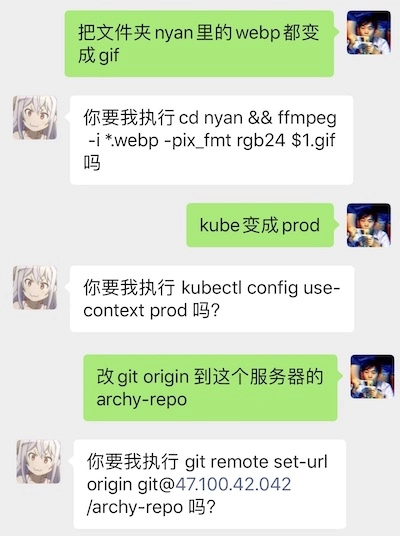Recently, a Chinese learning assistant ARCHY based on Wechaty started operating🤖🤖🍜~

To enable better readily availability for the assistant, I wrote this wechaty-log-monitor plugin to perform log-related DevOps for Wechaty running in production. This is a duet built on two chatbots.
The main feature of the plugin currently is “QR code rescue on disconnect”: when one Wechaty goes offline, another Wechaty will send a QR code to that Wechaty’s WeChat account to log in again.

This way, when disconnected, you don’t need to ssh into the production server, then sudo su git + pm2 logs --lines 100 to scan the code and log back in.
Now whether you’re eating, outdoors, or on the subway, when disconnected you can immediately scan the code to log back in.

1. How to “QR Code Rescue on Disconnect”
yarn add wechaty-log-monitor@latest
Just use createQRRescueOperation for botBob in botAlice.
import {qrResuce, WechatyLogMonitor} from "wechaty-log-monitor"
const qrResuceForB = qrResuce(({
logFile: "../botBob.log",
adminWeixin: "BobWeixin"
},{loginTest:"您好世界"}))
botAlice.use(WechatyLogMonitor({
enableSelfToBeQrRescued: true,
logOperations:[qrResuceForB]
}))
Also do vice versa for botAlice in botBob:
import {qrResuce, WechatyLogMonitor} from "wechaty-log-monitor"
const qrResuceForA = qrResuce(({
logFile: "../botAlice.log",
adminWeixin: "AliceWeixin"
},{loginTest:"#ping"))
botBob.use(WechatyLogMonitor({
enableSelfToBeQrRescued: true,
logOperations:[qrResuceForA]
}))
Just a few lines of code enable easier developer operations for reconnecting after disconnection. Improved readily availability: as long as the two don’t disconnect simultaneously, the other one can quickly be rescued!
p.s. After disconnecting, the bot will only send you one QR code. If you want the latest login QR code, just send “qr” to the bot.

2. Inside WechatyLogMonitor
Everything inside wechaty-log-monitor is functional. And very loosely coupled. Apart from unavoidable side effects in IO, it’s essentially completely pure.
The WechatyLogMonitor function mainly defines startWatchingLog and startReactingToCmds.
startWatchingLog is used as a callback for fs.watchFile + fs.createReadStream (implementation in watchAndStream), while startReactingToCmds is a callback for Wechaty’s message event.
const startWatchingLog = (bot:Wechaty,logOperations:WechatyLogOperation[])=>{
_.each(logOperations,(operation:WechatyLogOperation)=>{
const {onLogFileIsChanged, config} = operation
if(typeof onLogFileIsChanged === "undefined") return
const {logFile=""} = config
watchAndStream(logFile,(content)=>{
onLogFileIsChanged(bot,content)
})
})
}
export const watchAndStream = (file:string,callback:(content:string)=>void)=>{
if(!fs.existsSync(file)){
console.log(`file-to-watch ${file} not exist`)
return
}
fs.watchFile(file,{ interval: 2000 },(curr,prev) => {
const stream = fs.createReadStream(file,{start:prev.size, end:curr.size})
stream.on("data",function(data){
const chunk = data.toString();
callback(chunk)
})
})
}
The parameters onLogFileIsChanged and config both come from an object of type WechatyLogOperation. The previously used qrResuce actually returns an object of this type.
export const qrRescue = (
config: WechatyLogOperationConfig,parameter:{loginTest:string}
):WechatyLogOperation => { ... }
startReactingToCmds is similar to startWatchingLog above, self-explanatory.
3. Implementation of “QR Code Rescue on Disconnect”
The onLogFileIsChanged called in the startWatchingLog function depends on how the WechatyLogOperation object defines it.
export type WechatyLogOperation = {
config: WechatyLogOperationConfig,
onLogFileIsChanged?: WechatyLogFileLambda,
onCmdReceived?: WechatyCommandLambda,
}
Actually, qrResuce uses a global state isOtherBotAlive:boolean plus some regex to change the isOtherBotAlive “switch” based on strings written to the log, and changes to this “switch” call onOtherBotIsLoggedOut and onOtherBotIsLoggedIn.
const onLogFileIsChanged = async (bot:Wechaty, newLogs:string) =>{
const {adminWeixin} = config
if(globalState.isDisabled) return
if(globalState.isOtherBotAlive){
const latestQRCode = qrCodeAwaitingToBeScanned(newLogs)
if(latestQRCode) onOtherBotIsLoggedOut(bot,adminWeixin,latestQRCode)
}else{
const loggedIn = isUserLoggedIn(newLogs)
if(loggedIn) onOtherBotIsLoggedIn(bot,adminWeixin)
}
}
The regex in qrCodeAwaitingToBeScanned mainly looks for the two strings “INFO StarterBot…” and “INFO StarterBot onScan…”. (The WechatyLogMonitor parameter enableSelfToBeQrRescued: true will make Wechaty give corresponding logs for these two strings during login and when code scanning is needed, written into the log file.)
const qrCodeAwaitingToBeScanned = (lastFewLines:string):string|undefined => {
const signThatItIsLoggedIn = /INFO StarterBot Contact<(.*)?> login/g
const indexOfLastSignOfLoggedIn = getLastMatch(signThatItIsLoggedIn,lastFewLines)?.index || -1
const pattern = /INFO StarterBot onScan: Waiting\(.*\) - (.*)?\n/g
const match = getLastMatch(pattern,lastFewLines)
if(match) return match.index > indexOfLastSignOfLoggedIn ? match[1] : undefined
return undefined
}
4. Defining Other WechatyLogOperations
Overall, WechatyLogMonitor abstracts away “log watching callbacks” and “bot receiving message callbacks”, so in your WechatyLogOperation, you only need to selectively define onLogFileIsChanged and onCmdReceived.
For example, to write a WechatyLogOperation function closure to restart PM2, just a few lines:
export const restartPM2 = (config: WechatyLogOperationConfig, parameter:{pm2Id:number}):WechatyLogOperation => {
return{
config,
onCmdReceived : async (bot:Wechaty, cmd:string, config: WechatyLogOperationConfig) => {
const {adminWeixin} = config
if(cmd === "restart") execAndPipeToBot("pm2 restart "+parameter.pm2Id, bot, adminWeixin)
}
}
}

5. Auth and GPT-3 Features to be Developed
Currently, WechatyLogOperationConfig has a securityRule value, defaulting to None.
export type WechatyLogOperationConfig = {
logFile?: string,
adminWeixin: string,
securityRule?: WechatyLogOperationSecurityRule
}
export enum WechatyLogOperationSecurityRule {
None = 0,
SMSVerification, //not implemented
authy, //not implemented
googleAuth //not implemented
}
In the future, if we want to expand to using Wechaty for the entire production-related DevOps (not just Wechaty-related Operations, but also MongoDB-related Operations running in production, RESTful API server-related Operations, etc.) to create a simple, easy-to-use process for the team - essentially turning the chatbot into a simple terminal - then we can set more dangerous Operations to require SMS verification codes, authy, and other Authentication methods.
I believe the Auth feature will be one of the interesting development directions for the wechaty-log-monitor plugin.
Pragmatically speaking, if “turning chatbot into a simpler terminal” really works, another very interesting development direction would be combining with a very interesting GPT-3 application recently mentioned by OpenAI: Natural Language Shell - using natural language to execute Unix and other commands.

Author: Archy Will He (何魏奇), functional programmer, interested in computational semantics, currently working full-time on the ARCHY.SH project. Working with GPT-2 (and hopefully with 3 soon!)
GitHub Repo: wechaty-log-monitor plugin
本文也有中文版本。

 我如何用Chatbot在奇绩创坛重构销售体系
我如何用Chatbot在奇绩创坛重构销售体系